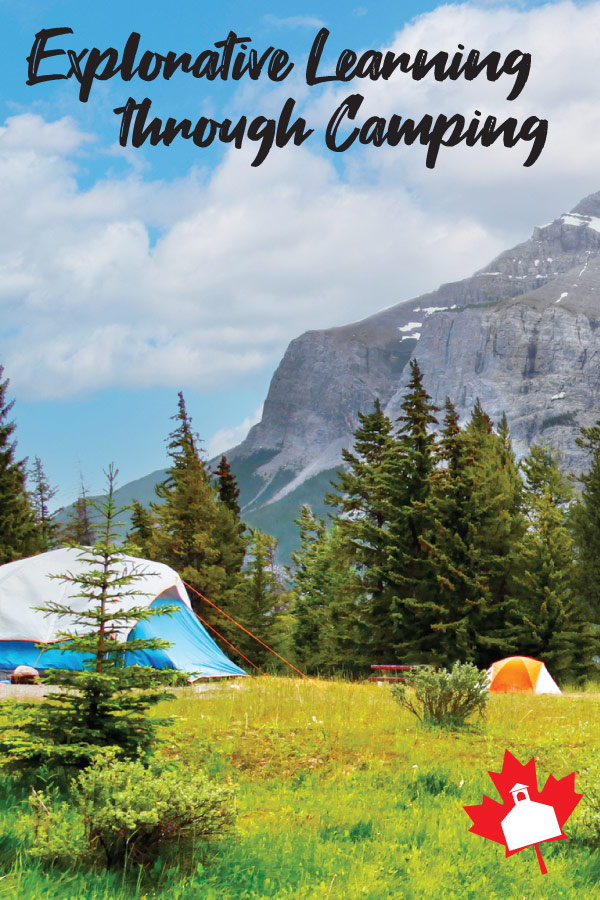

So many families across our country enjoy camping during the nice summer months. There are so many beautiful national, provincial, territorial, and private campgrounds all around our country. While not all homeschool families school year round, most would acknowledge that learning can and does happen everywhere. Your family camping trip is no different! Both history and science can easily be touched on naturally while on your camping trip. This is not an attempt to say that you need to be bringing school along on your summer camping trips but instead is an effort to show you that learning happens all around you!
Hands on Things to Be Discovered Camping:
Telling a Tree’s Age
If you are camping, you are likely having a campfire. If you are having a campfire, you have some logs. You could pass each of your children a log and explain to them what the rings mean (the age of the tree). Show them how to start at the inside and count the rings to see how many years old the tree is. Each person could see how old their log is and see who has the oldest and the youngest pieces. Perhaps they’re all the same and all from the same tree! You can do this on a hike or casual walk through the woods as well when you come upon tree stumps. While you’re at it, you may even see some downed trees with lots of roots exposed. What an awesome hands-on time to point out how the roots come out of the bottom of a tree and inform your children how those roots transport nutrients to the tree.
Fire Starting
The ability to start a fire is a wonderful and important survival skill for anyone to have. When better to practice this than when your family is ready to sit down to some yummy s’mores at the campsite! There are so many ways to start a fire and different commonly found items you can use as kindling if you don’t have any. There is so much good conversation to be had around the fire on how life would have been like for the first peoples and even for everyone who lived before the invention of electricity and other types of heat.
Living Things and Their Environment
This can be touched on in a quick discussion around the campfire or the picnic table. There are so many things growing! You can even have the kids make a list of living things they see around the campfire. (If you haven’t touched on the 6 characteristics that we use to classify if something is living, you could get into that here or just ask them questions like “Why do you think that is alive?”) Make a list of living things and then pick one to discuss. Ask questions like:
- What makes you say this is alive?
- How does it stay alive?
- What does this need in order to be alive? (oxygen, water, sun, nutrients)
- What type of things threaten this particular thing's life? (storm, predators, human influence, etc.)

Rubbings of Different Types of Leaves
These are fun art projects to see the different margins and veins on different leaves. Tracing is self-explanatory but can show some of the differences of margins such as scalloped, smooth, serrated, etc. These margins are important for identifying what kind of plant they come from. Leaf rubbings feel like a childhood right of passage! Put the leaf under a piece of paper and rub the long side of a crayon or a pencil crayon over the paper until you have the imprint of the leaf on the paper.
Deciduous and Coniferous Trees
Walk around (or even sit in your campsite) and look at the different trees. Send kids to see if the trees nearby have needles and cones or if they have leaves. See if they can find some of each. Use this time to talk to them about the difference between deciduous trees and coniferous trees. Deciduous trees are trees that have leaves and change colours, and coniferous trees are trees that have needles and often cones and don’t change colour in the fall.
You can use worksheets to teach these kinds of science facts, or you can get out into the forest and learn by seeing them! (Or combine the two if that’s your preference!)
There are many skills and knowledge that are learned just by being in, and engaging with, nature. These listed above are just a few examples, but there are countless more. For many children, hands-on discovery like this will stick with them much longer than things they hear during a lesson. Even just by being in nature, they are observing and learning things about their surroundings. You are doing great things for your children even by having them out in nature!
Related Articles:
This article has been written by homeschooling staff writers of The Canadian Schoolhouse (TCS). Enjoy more of our content from TCS contributors and staff writers by visiting our Front Door page that has content on our monthly theme and links to all our content sections.














